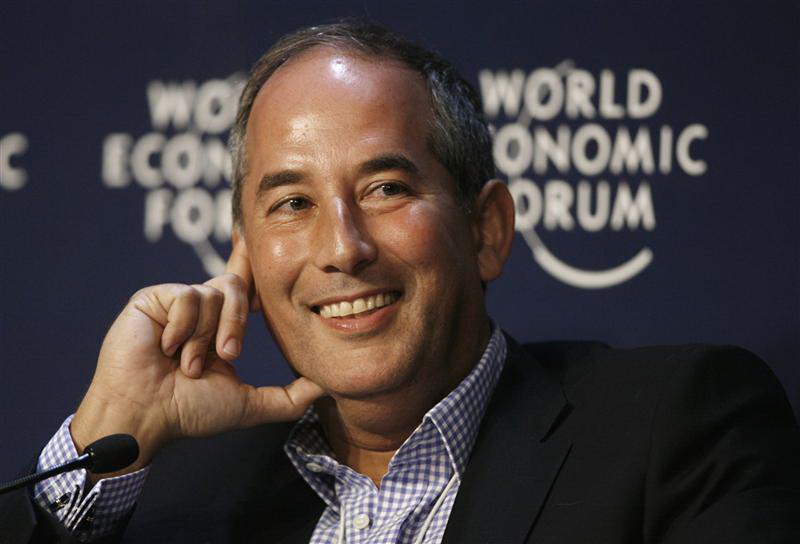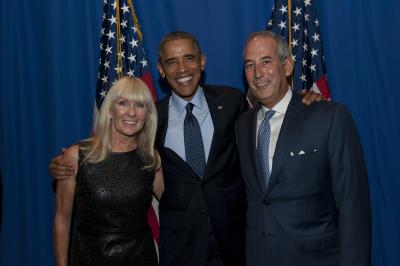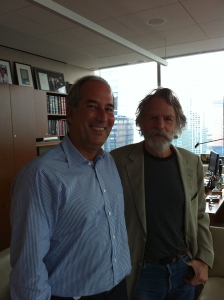OPA Key Note Speech
The two-way pipe – facing the challenge of the new content creators .
TOM GLOCER CEO REUTERS
About this time last year I stood up in front of a room like this at a Financial Times media conference. I talked then about the personalization of news – how technology was allowing consumers to filter exactly the news they wanted to receive. And how it was allowing content organizations like Reuters to multicast individual streams of desired content not just broadcast a single feed.
In a nutshell it was about the consumer as editor – you get the news you want when you want it either pulled by something like an RSS feed or a Tivo box or pushed by the media company – in this instance filtered by your profile.
Well 12 months on media companies are catching up with this demand but you guessed it our audiences have already moved on – now they are consuming creating sharing and publishing.
The consumer wants not only to run the printing press but to set the linotype as well.
My message today in this opening session of the OPA’s “Forum for the Future” is simple –our industry faces a profound challenge from home-created content – everything from blogging and citizen journalism to video mash-ups.
Over the next twenty minutes or so I want to talk about how companies like ours can meet this new challenge –
How if we create the right ”Crossroads” provide consumers with the appropriate tools and use “old” media skills like writing and editing we can harness the upside in what at the outset looks and feels very much like a punk revolution.
It is becoming clear that our media world is fundamentally changing again only a decade after the internet attracted the first wave of online publishers.
As media historians look back on this period they’ll probably identify News Corp’s recent acquisition of Intermix Media parent company of MySpace.com as a turning point.
Looking at the numbers cold $580 million was a lot of money to pay for a company with barely $20 million in revenues.
But sites like MySpace are redefining our world and providing an online forum for kids music groups their promoters and basically anyone with anything he wants to share.
Look behind the weirdness of some of MySpace’s inhabitants and Murdoch has now gained access to 54 million users (including one called Tom Glocer) – all potential customers for News Corp’s content.
More importantly he has the kind of market data that would make consumer industry bosses giddy – an early warning system of future trends and brand choices for the world’s youth market.
Mainstream media companies are now catching on to why 170000 new members are signing up each day and using this community to launch new albums like ones by the Black Eyed Peas or the Arctic Monkeys.
They’re also searching the community for mass-market talent.
Last fall Interscope joined forces with MySpace to launch its own record label – and it’s no surprise that Fox now plans to harvest potential talent via a MySpace film imprint.
What we are seeing on-line now is almost a continuous talent show with media-savvy consumers using digital technology to express themselves and stand out as individuals in their virtual communities as well as appeal to the Harvey Weinsteins and Simon Cowells of the world.
Click onto Stupidvideos.com and you see just that. There are thousands of videos – which are as the site accurately proclaims pretty stupid.
A mix between Candid Camera You’ve Been Framed and Jackass Stupidvideo gives all of us the opportunity to be a star – if only for our allotted Warhol 15 minutes.
And just like TV producers comb MySpace for talent traditional media companies advertise on Stupidvideos tempting users with the opportunity to “make it in Hollywood”.
The technology now available is also creating a kind of weird hybrid media where music and videos are being “mashed” together to create something new and original.
Go to Ourmedia.org (another of the sharing sites) and you’ll find things like “Weird Al” Goes to the Moon – a guy called Joshua Brock took a Weird Al Yankovic song and put it together with a NASA moon video.
Warner Music has recognised that there is a demand for exactly this new type of creativity – where “ordinary” people express themselves through music video mash-ups – and other labels I am sure will join suit.
MySpace Stupidvideos Ourmedia represent exactly the kind of grey area between homemade content mass audiences and traditional media disciplines.
But there is a difference between the currently small-scale new hybrid media and the mass popularity of MySpace blogs.
Through Pepys and Boswell to F. Scott Fitzgerald Woolf and Bridget Jones – the diarist has always been a common thread through literary history.
But in the same way if we want to best understand the plague years in London we read Defoe future generations will turn to our bloggers to decipher current events.
The 2004 U.S. Presidential Election was the first White House race in which blogging played an influential role. According to a Pew report released after the election 9% of Internet users said they read political blogs “frequently” or “sometimes” during the campaign.
And by breaking stories or pushing issues – like the Swiftboat veterans – blog sites extended their influence beyond their readership base to the national media. In effect bloggers became the story.
But let’s be really clear about what’s changed. It’s of course the nature of publishing. A Gutenbergian transformation has resulted in wooden and metal letters being replaced by the laptop computer and the Internet.
It’s only taken over five hundred years.
But of course just because anyone can now publish their own diary of views (and it is estimated that there are more than 80000 new sites each week) it doesn’t mean that there’s a ready market of consumers.
Not everyone has the potential to be a Salam Pax .
The difference between now and the 1990s is the scale of distribution and the ability to search.
Like diaries and blogs citizen journalism also has a long history. Were the on-line accounts of survivors from the deadly wave that struck Asia on Boxing Day 2004 really so different to Elizabeth Shutes’ experience in 1912:
“Suddenly a *** quivering ran under me apparently the whole length of the ship… Someone knocked at my door and the voice of a friend said: ‘Come quickly to my cabin; an iceberg has just passed our window; I know we have just struck one’.”
Give Shutes a digital camera and a YouTube account and you’d get what we are experiencing today.
But let’s get to the nub of the issue that confronts us.
If users want to be both author and editor and technology is enabling this what will be the role of the media company in the second decade of this century?
I would argue that there are three distinct attributes:
1. First the ‘seeder of clouds’.
What do I mean by that?
Well if you want to attract a community around you you must offer them something original and of a quality that they can react to and incorporate in their creative work – just like Warner’s music to enable video mash-ups. Being authentic in what you create and deliver to your audience is essential for success.
But it’s no good hoping that new content creators will magically be drawn to us – we need to attract them. That means making the most of the content we already produce and setting out our electronic stall.
If you attract an audience to your content and build a brand people will want to join your community and interact. They’ll be inside your tent.
This is as true for traditional “letters to the editor” on the op-ed page as it is for MySpace.com.
2. The second role media companies need to adopt to maximise the opportunity from new content is that of ‘the provider of tools’.
Maybe the French will create a better Google or a CNN a la Francaise but I don’t see a lot of private money lined up behind this lot.
We need to promote open standards and interoperability to allow a diverse set of consumer-creators to combine disparate content types. We must enable our content to be at the Crossroads of our audiences’ consumption – and realize that no one fully “owns” audience anymore.
Let’s not make the same mistake that newspapers did with the protectionist online strategies that characterised Internet One: The Web was not created to merely display a replica of yesterday’s newspaper with a few banner ads.
3. Third the final role that media firms will play in the emergence of the two-way content pipe is that of ‘Filter and Editor’.
In my mind media has always had these two functions – to allow and to filter – one without the other is death.
I believe that the world will always need editing just as consumers place value in others making decisions about what is good and what is not.
Just because everyone now has the potential to publish their own blog doesn’t mean they’re all worth reading.
And just because Warner Music could let me mix Bjork and Lil’Kim with Elmer Phudd doesn’t mean a new Wagner is born – although I wouldn’t want to write it off.
So the role of companies like ours is to edit and filter – to provide open tools and to seed the clouds with content that encourages contributions. And then the skill to spot the gold in the pan of water and dirt. Because what looks niche now has the potential to gain mass appeal and eventually go mainstream.
The good stuff will float to the on-line surface.
Here in Britain in the 1980s the rise of the fanzine was seen as a threat to magazine publishing. But what happened to the successful fanzine editors who went on to edit men’s magazines like GQ will inevitably happen to the successful new content creators – in fact it’s already happening take my earlier example of Salam Pax whose work is now available in deep breath…paperback.
It’s exactly what happened to the underground club DJs whose re-mixes of established songs emerged as mainstream classics themselves.
Now at Reuters we are working hard to incorporate all this thinking into our services.
For many years Reuters has encouraged professional and non-professional journalists to contribute their pictures and video.
And it’s worked very well indeed – take this photograph – it captures the sheer horror of the doomed Air France Concorde on take-off. You feel like you are actually there on the ground watching with all the shakiness adrenaline and blurred terror of it.
It was the image burned in our collective memories of that terrible crash. Reuters had it because two Bulgarian plane spotters knew who we were and how to get in contact – in essence we’d successfully put up the open for business sign.
It was that mix of the on-the-scene amateur backed up by the professional capturing the aftermath that knitted the story together in a way that brought our customers closer to the event.
This pro-am cooperation reached new heights in the coverage of the Asian Tsunami.
On the day the Tsunami struck Reuters had 2300 journalists positioned around the world mercifully none were on those beaches. On that fateful day we also had 1000 stringers around the globe – but none of them were there either.
So for the first 24 hours the best and the only photos and video came from tourists armed with 1.3 megapixel portable telephones digital cameras and camcorders. And if you didn’t have those pictures you weren’t on the story.
However by day 2 our journalists got to the affected areas and it was a Reuters professional cameraman Arko Datta who took the iconic images which made the covers of the Economist Time and Newsweek that week and which won us the World Press Photo Award.
So in the end you have to be open to both amateur and professional to tell the story completely. There is no monopoly on being in the right place at the right time.
Professional content if available will generally be the authoritative article or photo if there is time but it can be complemented by audience created content in the first instance.
So… we are now at our Crossroads. Old media (and ironically enough) that now means on-line publishing as well has a choice – adopt these three roles to prosper or risk becoming less relevant.
1) To be the seeder of clouds;
2) To provide the tools for creation and;
3) To filter and edit.
We cannot be the choke-hold in a desperate effort to close the pipe – to block the new creators of content in a bid to protect our businesses.
But we need not be so fearful either. It’s easy to paint a disaster movie of a fragmented media world where millions of bloggers and “citizen journalists” offer an alternative to the BBC CNN and god forbid Reuters.
But I don’t believe this will happen for two compelling reasons:
First too much choice often means no choice at all.
Imagine going into a restaurant and being given a blank piece of paper – “order whatever you want” you are told. What do you eat? How do you know what the chef considers his specialities? While it is important to have the illusion of choice people generally like less choice not more.
The consumer consciously or not focuses on what he knows what is familiar and above all what is trusted. This is why brands really matter.
Look at multi-channel TV or the Internet.
On digital TV in the UK you can access around 500 channels but what are the most popular? It’s not the Dating Channel (although I can’t speak for everyone in the room)- it’s BBC1 BBC2 ITV and Channel 4.
The Internet has millions of websites to choose from but how many do you actually visit regularly? I would argue that it’s probably no more than a handful.
The second reason to suggest content fragmentation does not mean disaster is this – we don’t have unlimited time to spend looking for new content.
Time is a non-renewable resource and one of the major influences in decision-making –- there are only 168 hours in the week and evidence shows that people don’t want to spend extra time searching for new information. Again brands serve a filtering function.
None of us has the time to go searching through hundreds of sources to pull out what is interesting and what is relevant. Choice means letting the professionals do that for us and sometimes letting the wisdom of crowds have a go – I confess I do look at bestseller lists and most frequently emailed stories.
So in summing up I believe that the role that “old” media companies have in the truly “new” media age is that of content facilitator or seeder of clouds tool provider and editor.
We are the go-between – providing the structure and support – the connective tissue between the information supplier and the consumer even if they are often today the same person!
And really is that so different to what Julius Reuter did in 1851 passing market information between creators and consumers of those prices? His pipe wasn’t initially a digital one – but it is now. Banks contribute their prices to Reuters and we aggregate them add value and sell them back to the banks and others.
Finally in all this crazy mash-up of new content bloggers citizen journalists two-way pipes the issue of trust becomes critical.
Since the growth in broadband usage and search fact and fiction have become dangerously blurred.
Consider this: a couple of weeks ago Wikipedia’s 19-page entry for Tony Blair changed 25 times within that week. One new entry claimed that Blair’s middle name was “Whoop-de-Doo” and the Prime Minister had had a poster of Adolf Hitler on his bedroom wall as a teenager.
How many people now believe that man didn’t go to the moon and NASA staged the landing in a Californian movie studio? I bet a lot more today.
With this confusing backdrop the consumer gravitates to the trusted brand – like Reuters I hope.
I believe that increasingly in a media market dominated by multiple sources trust will become a key differentiator and a critical determinant in consumer decision-making.
Now what does that mean for Google and its decision to accommodate the Chinese authorities? I don’t think we really know yet. Reputation is hard won and quickly lost.
Just look at the impact on reputation that the Kelly Affair had on the BBC or Jason Blair on The New York Times.
These institutions recovered through decisive action but if you lose the trust of your audience you lose your audience. Full stop.
In conclusion then while writing a diary publishing photographs and making videos aren’t exactly new phenomena access to the printing press is.
But in an echo of the fears that Hollywood studios had after the success of the Blair Witch Project not all media consumption will be home-created blogs – in the same way not all movies were made on a shoestring budget filmed on a shaky camcorder.
Don’t make the same mistake we made as an industry at the birth of on-line.
Protectionism doesn’t work – but neither does total surrender.
As media companies we have access now to a rich new world of sources of talented writers photographers film-makers would-be journalists political diarists stand-up comics actors musicians.
Let’s not turn away from the potential of all of this. But understand it and unlock it.
User created content has become part of our media world – but it’s part of the overall mix not the sole component.
Understand it. Encourage it.
Recognise that if you act now you might just make it to Web 3.0.





